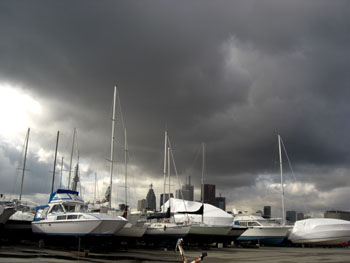About Cherry Street Cats
 It’s just started to snow and Aaffien May is crouched on all fours on Toronto’s waterfront, peering under a boat, calling out for Jackson Pollock.
It’s just started to snow and Aaffien May is crouched on all fours on Toronto’s waterfront, peering under a boat, calling out for Jackson Pollock.
“Jackson! Jacks!” she calls.
A few moments later, Jackson’s furry black head pops up from inside the boat. Then, as if coming out from hiding, more cats start to appear. First it’s two, and then three and four. When she opens the first tin of cat food, we’re surrounded by close to 10.
Welcome to the Cherry Street cat colony, home to 25 feral cats. Ms. May, a nurse, and a group of other Toronto residents have been caring for the cats over the past year. Every day, at least one person feeds and checks on them.
A friend of Ms. May’s, Sandi Hudson, a retiree who sits on the Toronto Humane Society board, first found the cats while looking at boats at the boatyard at the corner of Cherry and Commissioners streets last January.
They don’t know how long the cats have been there or why, although a leading theory is that the colony’s first cats were left behind by residents evicted from the nearby Tent City back in 2002.
“But it’s just a thought,” Ms. May says. “No one knows for sure.”
 Ms. May, who works at Toronto General Hospital and has five cats of her own, admits the time and devotion she puts into caring for the cats is unusual, but insists she’s not a “crazy cat lady.”
Ms. May, who works at Toronto General Hospital and has five cats of her own, admits the time and devotion she puts into caring for the cats is unusual, but insists she’s not a “crazy cat lady.”
When she first went to see the cats, she hadn’t planned on committing so much time to them.
“But before I knew it,” she says, “I was head over heels in love with them.”
Ms. May, who is recovering from recent foot surgery, makes the pilgrimage by subway and bus a few times a week.
Arms loaded with cat food, a cat carrier and a backpack full of supplies, she weaves her way through the yard, and the thick odour of garbage trucks parked nearby.
“Jackson is the head of the cats,” Ms. May says.
“He’s always the first to greet us and the last to see us leave. There’s a definite pecking order and he’ll chase the others away if he doesn’t like them eating from certain bowls.”
Then there’s Hemingway, an old white cat who, as Ms. May explains, “You can just tell has seen a lot of battles.”
Virginia Woolf, or “Mama Gini,” as she’s more often called, recently gave birth to two kittens, Oscar Wilde and Emily Carr.
The older cats that are completely feral and cannot be domesticated are brought to the Humane Society to be spayed or neutered, and then returned to the cat colony. The kittens are put up for adoption.
Some of the cats didn’t make it through last winter, so Ms. May and her friends have been collecting old blue and grey bins in hopes of helping the cats through this winter.
They’ve been sealing the insides of the bins with pink insulation, turning them upside-down and stuffing them with straw to build “kitty condos.”
They’ve already set the condos up on top of skids in the boat yard, and are currently deliberating whether the condos should be one storey or two.
Although the group receives donations from neighbours and local businesses, she estimates they spend at least $15 a day on cat food alone, with much of it coming from their own pockets.
“People just abandon cats,” Ms. May says. “It’s really sad that people think pets are so disposable.”
1. Sandi Hudson | April 25, 2009 at 3:29 pm
Sandi Hudson | April 25, 2009 at 3:29 pm
We have lost 2 more of our precious ferals, Buddy a grey tabby who watched us with caution but came to eat using his paw to scrap food from the bowl, and Marmalade who was a newcomer to the colony and we saw very little of him. Both of them were found during the cleanup of the shelters, both had gone to one of the boxes, nestled into the straw and peacefully passed away to kitty heaven.